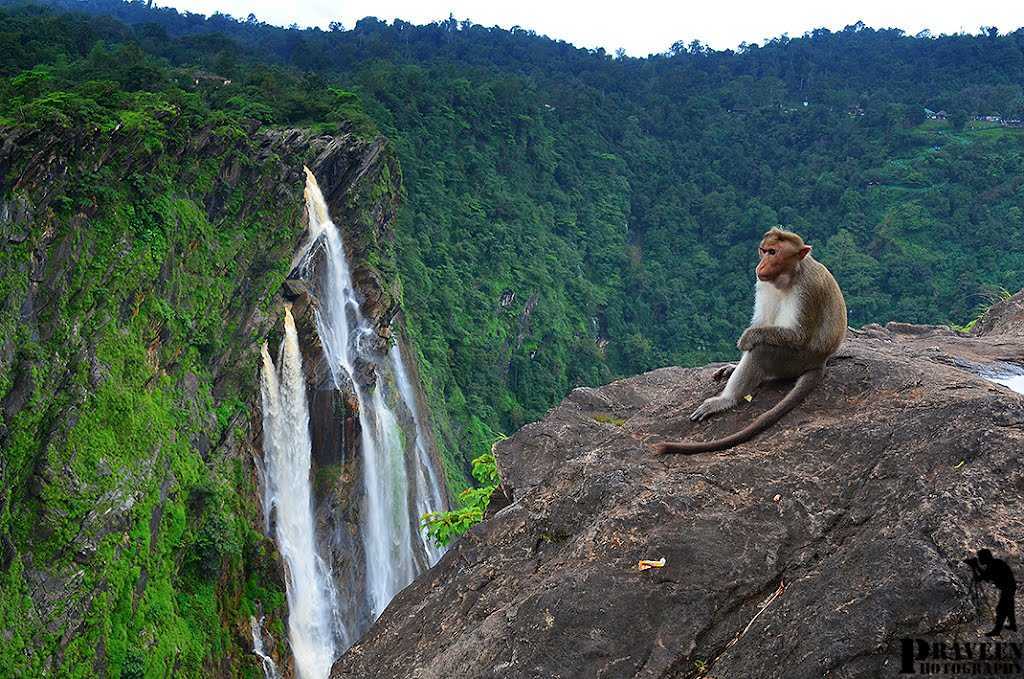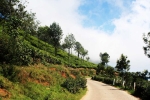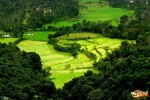Shimoga (Shivamogga) Tourism
With nature in its full bloom, the town of Shimoga has been a home to several great dynasties and kingdoms. Steeped in rich heritage and culture, this main city of Shimoga District derives its name from the words 'Shiv-Mukha' implying 'Face of Lord Shiva'.
Packed with several marvels of nature in form of picturesque landscape, gorgeous waterfalls, mystical temples and lush green surroundings, its raw beauty will leave you absolutely enchanted. Blessed with swaying palms and verdant paddy fields, the place has earned itself a nickname of rice bowl as well as the bread basket of Karnataka. With four rivers namely Sharavathi, Kumudavath, Tungabhadra and Varada making their way into the city, gurgling and bubbling adds mystical charm to the region. Pleasant weather, beautiful rolling hills, profusion of areca nuts and endless list of attractions has made this place a must for enthusiastic vacation makers.
Download Shimoga (Shivamogga) PDF Guide >
What's Great?
You can enjoy trekking and river rafting in Shimoga. Is a unique destination with a stark contrast between the old world charm and the global village.
What's not so Great?
Not a well developed tourist destination. Food and water can prove to be a problem for some.
For Whom
Shimoga is an ideal destination for adventure lovers. You can enjoy trekking and river rafting. It is also a perfect destination for wildlife lovers, thanks to its tiger and lion forest reserve, and Jog Falls. You can go there with your colleagues, family, and friends for a perfect weekend getaway.
Backpackers' delight
If you are a hippy at heart, there are a lot of places that you can enjoy in Shimoga. The main tourist attraction is the mighty Jog falls. They are the highest falls in India, and it is a sight worth seeing. There are also a lot of options for trekking like the Kodachadri trek which is an exuberant trek to the Kodachadri peak, which is endowed with dense forests, jungle trails and picturesque landscape; and also the trek in the Kudajadri hills. They all have something different and mesmerizing to offer. You can also do river rafting, kayaking, and canoeing in the Sharavathi Nature trails which is an off-beat idyllic ecological paradise with numerous waterfalls.
History
The history of Shimoga dates back to at least 2,000 years to 3rd Century AD. Shimoga was established by the Keladi rulers and it is said that it enjoyed a golden rule during the reign of Keladi Shivappa Nayak in 1600 AD.
It bears signs of prehistoric life and culture in the Neolithic and Megalithic eras of the Iron age. Remains discovered at Guddermadi, a place two kilometres from the main city proves the existence of ancient life.
Shimoga has been under the rule of various rulers and dynasties, from the Mauryas, Satavahanas, Kadambas of Banvasi, Chalukyas, Rashtrakutas, and rulers of the Vijayanagara kingdom. It was later annexed by Haider Ali and remained a part of the kingdom of Mysore until the Indian independence.
It has made its place in the fairly recent documented history of the Indian freedom struggle as well. It was in Hechche village of Shimoga where the women of the village offered to undergo a Satyagraha movement. In his travels for the freedom movement, Mahatma Gandhi also visited this place.
Etymology
At first glance, Shimoga sounds like just another regular town name. But, have a closer look at the history of the name and it reveals not one or two, but four stories behind its name. The first three stories are linked to Lord Shiva, where the name is either a colloquial usage of Shiva-mukha, meaning the face of Lord Shiva, Shivani Moggu meaning nose of Lord Shiva or to Shivanna Mogge flowers which are offered to the great lord. Another story relates the name to the time of famous sage Durvavsa, known for his flaming temper. It is believed that Durvasa always kept a pot boiling full of sweet herbs and once, some cowherds came across the pot and called it Sihi Moge (sweet pot), after which Shimoga was later named.
Shimoga has now been officially renamed as Shivamogga.
Art and Craft
Shimoga is host to a thriving art and craft industry. The most famous craft is carried out by the Gudigar clan of craftsmen which dwells in Shimoga and practices this sophisticated art of carving specialised intricate figures and patterns out of natural wood and sandalwood. It?s easy to shop for these wood figurines in Shimoga as the State Government has exclusively undertaken the sale and purchase of these items.
Culture
Shimoga is better known as the cultural capital of Karnataka, and the people of the town take immense pride in their culture and heritage. The cultural ambience is vibrant with music, drama, and dance in every beat and this is often attributed to the rulers of Shimoga who were great connoisseurs of the performing arts.
The city dwellers have known for their tender nature, and affectionate hearts and religious harmony is commonplace here. While Kannada is the most widely spoken language, Hindi and English are also understood and spoken in most parts. A tiny section of the population converses in Urdu as well. Havigannada, a unique vernacular of Kannada is also spoken in this part of Karnataka.
Dollu Kunitha and Yakshangana are the two most popular dance forms of Shimoga, and if you fancy learning some traditional, quintessentially South Indian dancing, you can do so at the numerous dance classes offered in the region.
Talk about any culturally rich Indian town, and it remains incomplete without vibrant festival celebrations. Dasara is the most popular festival in Shimoga when the entire city is bedecked like shining jewels, and some fairs and exhibitions are held. Other popular festivals are Palapushpa Pradarshana which is a flower exhibit, Kodachadri Vyabha which promotes regional craft, and Marikamba Jatre which invokes and honours Goddess Marikamba.
One Day Itinerary
Shimoga is a small place that can be explored in 1-2 days. It is better if you stay for two days. On the first day, you can start by visiting the Sakrebyle Elephant camp early in the morning. Then you can visit the Mangadde bird sanctuary during the afternoon, and end the day by an evening safari at the Tyavarekoppa Lion & Tiger sanctuary. You can try authentic south Indian food at night.
The next day, you should start early morning and visit the Jog falls which are a must visit. If you are interested in trekking, you can opt for the Kodachadri trek; or you can try your hand at river rafting, kayaking, and canoeing in the Sharavathi Nature trails. On your way back, you can visit the Shivappanaika Palace Museum and the Gajanur dam.
Restaurants and Local Food in Shimoga (Shivamogga)
Shimoga is a getaway with tourist pouring in large number. Being located in South India one may expect the South Indian cuisine to be predominant in the area. Paayasa, Thambli, Avalakki are some of the popular dishes in Shimoga.
View 3 Restaurants in Shimoga (Shivamogga) >>
Jul-Decis the best time to visit Shimoga (Shivamogga)
With seasons rotating, the town of Shimoga sways between dry and wet. Monsoon season hits the town somewhere between June and October and transforms the place into a paradise all refreshed and blooming. The rivers and waterfalls are spurting in full force and present a beautiful sight. It is best to visit the town between the months of July and January.
Weather in Shimoga (Shivamogga)
Loading...
Shimoga (Shivamogga) in Summer (April-June)
The summer season brings a lot of heat and humidity to the area. The temperature goes as high as 36 degrees Celsius. You won't be able to enjoy any outdoor activities during this time because it will be too hot.
Shimoga (Shivamogga) in Monsoon (July-September)
Shimoga experiences heavy rainfall during this period. It is not an ideal season to visit Shimoga but if you are willing to take the risk, you can. It won't be crowded during this period.
Shimoga (Shivamogga) in Winter (October-March)
The winter season forms the best season to visit Shimoga. The torrential rains which wash the place pre-winters add to its beauty. The weather also remains fresh and pleasant during this season.
Monthly Weather in Shimoga (Shivamogga)
Month
Avg. Minimum (°C)
Avg. Maximum (°C)
January
20
33
February
21
34
March
23
34
April
25
35
May
25
34
June
24
29
July
23
28
August
23
29
September
23
29
October
22
31
November
21
33
December
20
32
Events in Shimoga (Shivamogga)
Ganesh Chaturthi
23rd September
Ganesha, the supreme God of knowledge, prosperity and good fortune, is celebrated with much fanfare on the auspicious ocassion of Ganesh Chaturthi in Shimoga. On the 11th day the statue is taken in a huge procession to be immersed in the sea, symbolizing a ritual send-off to the God, as he goes to his abode.
Pongal
15th - 18th January
Situated on the banks of the Tunga River, Shimoga dates back to the third century. The most awaited festival in Kerala, Pongal, is celebrated with great vigor and enthusiasm in Shimoga. Jaggery, cardamon and cashew nuts are prepared in many different ways, and are must trys.
Bird Watching at Mandagadde Bird Sanctuary
Throughout the year
One of the best bird sanctuaries in India, Mandagadde is a must visit if you happen to be in Bangalore. In peak season over 5000 species of birds can be spotted here. If you want a closer look at the nesting birds, a boat can also be hired. Another interesting attraction are the elephant camps, where you can even give the elephants a bath!
Bird Watching at Gudavi Bird Sanctuary
Throughout the year
Located in Karnataka, a beautiful lake surrounded by birds nesting on trees is the postcard perfect Gudavi Bird Sanctuary. According to a 1991 survey, over 191 species of birds can be spotted here. The black headed crane, grey heron, waterfowl and white ibis, are all found here.
Comments on Shimoga (Shivamogga)
Post Your Comment


 Jog Falls
Jog Falls Kodachadri
Kodachadri Agumbe
Agumbe Mandagadde Bird Sanctuary
Mandagadde Bird Sanctuary Chikmagalur
Chikmagalur Gokarna
Gokarna Kemmanagundi
Kemmanagundi Goa
Goa Ooty
Ooty Coorg
Coorg